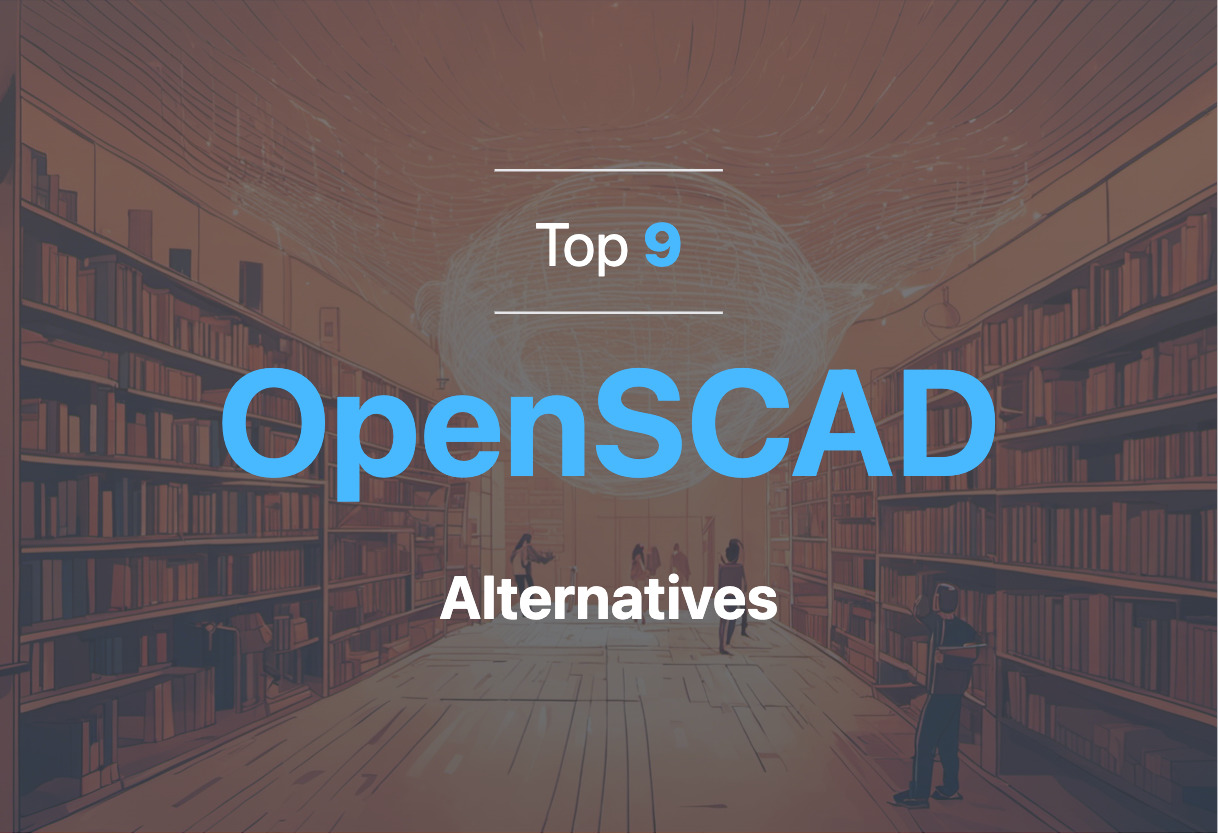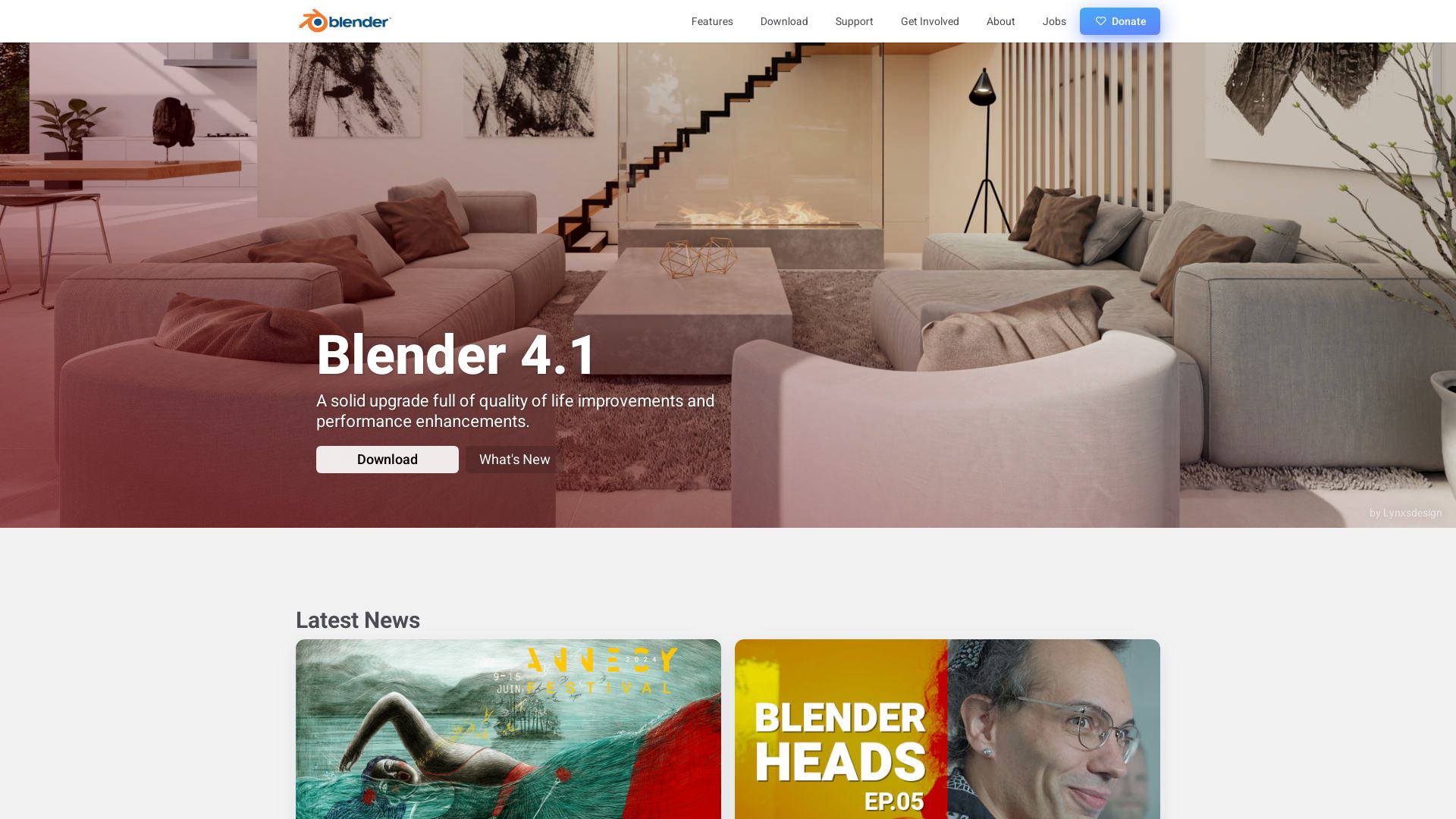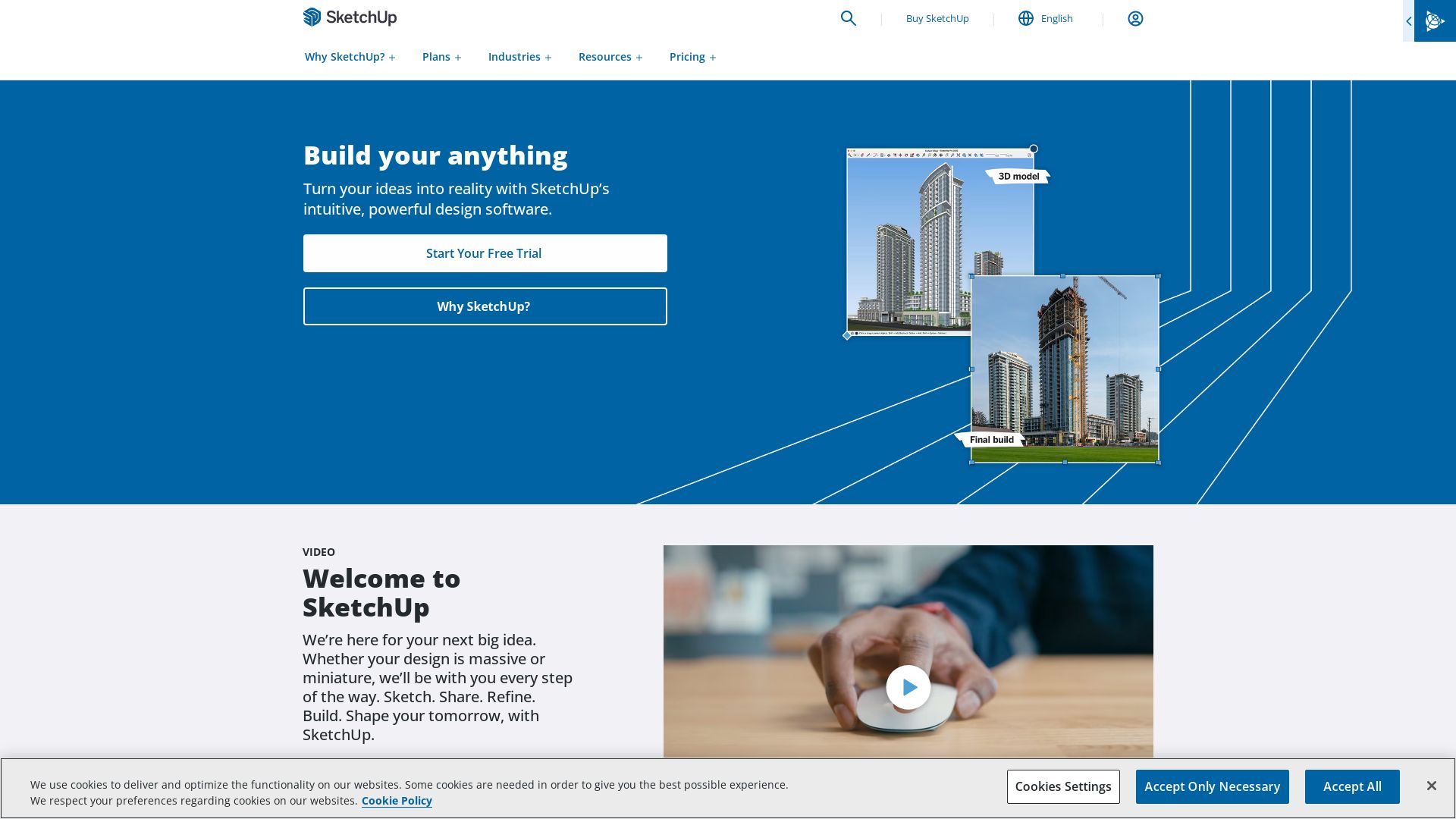OpenSCAD is a free software for creating solid 3D CAD objects, operating on various systems such as Linux, macOS, and Windows. It employs its own description language and is known for its precise modeling of machine parts and 3D printed designs. The stable release in 2021 continues to offer powerful capabilities with a focus on CAD aspects.

Exploring alternatives to OpenSCAD, users can consider FreeCAD, LibreCAD, Tinkercad, AutoCAD, Fusion 360, Blender, SketchUp, Onshape, and Wokwi for their 3D modeling needs.
FreeCAD

Delve into the expansive universe of FreeCAD, a general-purpose 3D CAD modeler and BIM software, feted for its compatibility across Linux, macOS, and Windows. This free, open-source gem is endowed with FEM support, aimed primarily at mechanical engineering and product design, yet it graciously expands into wider engineering applications.
FreeCAD Top Features
- Feature-based parametric modeler: Adapt 3D models through 2D sketches and parametric model modifications.
- Python-extensible functionality: Create bespoke 3D modeling experiences and functionalities through Python extensions.
- Modular software architecture: Seamlessly incorporate new modules without adjusting the core system.
- Arch Module Extension: Extend architecture, electrical, construction, to AEC engineering sectors.
- G-code Support for 3D Printing: Effortlessly print your 3D designs.
| 3D Models Searcher | Integrated with CADENAS and 3DfindIT.com to ease model searching. |
| File Formats Supported | Caters DXF, SVG, STEP, IGES, STL, OBJ, DAE, SCAD, IV, and IFC file formats |
| User Community | A mammoth of an active user base with over 25,000 forum members. |
FreeCAD Disadvantages
- Limited 2D Drawing and Animation Capability: Possesses some constraints in direct 2D drawing and animation.
- Restricted DWG Support: Software licensing issues with GNU LibreDWG library restrict native DWG format support.
FreeCAD Pricing
FreeCAD is a free and open-source software, welcoming all with a broad embrace to explore its exceptional features and functionality.
FreeCAD Use Cases
Use Case 1: Mechanical Engineering Product Design
FreeCAD shines in creating real-life object simulations, designing products as solid structures from 2D sketches, making it a perfect match for mechanical engineering and product design.
Use Case 2: Broader Engineering
From electrical engineering to construction, FreeCAD spreads its capabilities to encompass varied engineering spheres, assisted by the versatileArch Module extension.
Use Case 3: 3D Printing
With integrated G-code support, FreeCAD is optimized for 3D printing enthusiasts, delivering precise and quality prints of their spectacular designs.
LibreCAD

Welcome to a world of unparalleled 2D design capabilities courtesy of the open-source magic known as LibreCAD. Exclusively engineered for Windows, Apple, and Linux, this visionary software, born from a project aimed at enriching QCad, has soared beyond its origins to become an industry game changer.
LibreCAD Top Features
- Wide Range of Formats: LibreCAD can read DWG, DXF, JWWCAD, LFF, CXF files and write DXF, SVG, PDF, offering flexibility like never before.
- Customizable UI: Tailor toolbars and menus as per your preferences. Rediscover the joy of customization with this highly personalized user interface.
- Community Involvement: Be part of the LibreCAD family by contributing in various capacities such as coding, writing, testing, and translating.
- Exporting Features: It allows users to export files to PDF, BMP, ICNS, ICO, JPG, PBM, PGM, PNG, PPM, TIF, WBMP, WEBP, XBM, XPM formats.
- Lightweight: It’s a lightweight app allowing for quick reactions to commands, saving time and enhancing efficiency.
| Feature | Description |
|---|---|
| Compatibility | LibreCAD is compatible with AutoCAD and can be used for technical drawing purposes, making it a versatile tool for designers. |
| 2D Design Capabilities | LibreCAD offers a comprehensive suite of drawing tools including line, polyline, spline, circle, ellipse, text, dimension, blocks, and hatches. |
| GPLv2 License | LibreCAD is available under the GNU General Public License GPLv2 making it’s source code free to modify. |
LibreCAD Downside
- LibreCAD is limited to creating 2D designs. It cannot support 3D design features.
- Certain features might require users to go through the available user manual or online tutorial for proper understanding.
LibreCAD Pricing
Get ready to break the bank! Just kidding. LibreCAD is free! Yes, you heard that right. This magic wand of 2D design is open source and doesn’t cost a dime.
LibreCAD Use Cases
Use case 1
With LibreCAD, you can effortlessly create quick prototype designs. Its compatibility with various file formats makes it a powerful tool in the conceptual stage of design.
Use case 2
LibreCAD is a godsend for those working on architectural projects. Its robust 2D capabilities ensure that detailed blueprints can be designed with ease.
Use case 3
LibreCAD finds extensive use in CAM CNC machinery design. Its lightweight nature and rapid reaction to commands make the design process smooth and efficient.
Tinkercad

Enter the world of Tinkercad, a free 3D modeling software owned by Autodesk, that has been bringing constructive solid geometry to life since 2011. Pioneered by ex-Google engineer Kai Backman and Mikko Mononen, it’s the go-to platform for educators, innovators, and curious minds alike.
Tinkercad’s Boldest Features
- Build your design universe with a standard library of primitive shapes or custom-create shapes with a built-in JavaScript editor.
- Import shapes in diverse formats like STL, OBJ (3D), SVG (2D), and even export them in STL, OBJ formats.
- Unleash the creator in you with Tinkercad’s famous ‘Circuit Section’, an intuitive and feature-rich electronic circuit simulator.
- Want to witness your designs come alive? Try it on your iPad with amazing AR capabilities.
- A user-friendly interface, coupled with powerful modeling capabilities, makes Tinkercad a top pick. Create, save, and share 3D models in STL, OBJ, and SVG formats.
| Who’s it for | Why they’ll love it |
| Beginners | Easy-to-use interface, drag and drop functionality, and an abundance of support resources. |
| Advanced Users | Flexibility to design complex analog circuits, multi-board simulations, and advanced modeling features. |
| Young Users | Safe, secure, and a perfect way to test the waters in 3D design and printing. |
Tinkercad’s Hitches, Glitches, and Limitations
- Performs less favorably compared to SketchUp, Fusion360.
- Requires a WebGL-enabled browser – not all browsers support WebGL.
- Being online-based, performance heavily depends on network connectivity.
Tinkercad Pricing
A cherry on top – Tinkercad is absolutely FREE! Explore, innovate, and master the art of 3D modeling without worrying about licensing costs.
Tinkercad Use Cases
Use case 1: The Classroom
This software makes 3D design and printing approachable, stimulating creativity, and fostering problem-solving skills among students.
Use case 2: The Tech Beginners
If you’re just starting to navigate the waters of 3D design or electronic circuit simulation, Tinkercad provides a beginner-friendly platform to explore.
Use case 3: The Advanced Tinkerers
For the experienced designers and circuit specialists, Tinkercad’s feature-loaded environment offers a platform for honing skills, pushing limits and shaping innovative designs.
AutoCAD
An embodiment of the marriage between art and technology, AutoCAD by Autodesk has been leading the world of computer-aided-design (CAD) since its inception in 1982. A trailblazer in its field, it effortlessly produces 2D and 3D drawings while providing a solid platform for idea conceptualization, sleek designs, and precision.
AutoCAD Top Features
- Global Adoption: Embraced by architects, engineers, project managers, and animators alike, AutoCAD has earned its reputation as the go-to CAD software globally.
- Customizability: Wielding the power of Application Programming Interfaces (APIs), AutoCAD allows for customization, automation, and even the addition of new features.
- Variety of Vertical Products: AutoCAD has branched out, supporting the creation of vertical products such as AutoCAD Architecture, AutoCAD Electrical and AutoCAD Civil 3D.
| Feature | Benefits |
|---|---|
| Design and Drafting Precision | Enables the production of designs to the required technical accuracy in various industries. |
| Drawing/version History | Facilitates the tracking and understanding of design evolution by storing different drawing versions. |
| Strong Support for File Formats | Accepts a range of file formats, preferred by most 3D printers, promotes integration with applications such as 3D Max. |
AutoCAD Downsides
- Learning Curve: AutoCAD’s plethora of functions and commands may initially be overwhelming for those new to CAD software.
- Cost: Following a change in pricing model to subscription-based on 1st August 2016, perpetual licenses are no longer available, potentially raising cost concerns for some users.
AutoCAD Pricing
Moving into the digital age, AutoCAD transitioned from selling perpetual licenses to a subscription-based pricing model on the 1st of August, 2016. This model aims to offer users greater flexibility and adaptability.
AutoCAD Use Cases
Use case 1 – Construction Industry
AutoCAD emerged as an instrumental tool in building the Shanghai Tower, ensuring precise capture of its unique twisted structure and supporting environmentally friendly construction efforts.
Use case 2 – Entertainment Industry
AutoCAD’s reach extends to the entertainment industry, where its 3D animation software lays the groundwork for high-quality content generation.
Use case 3 – Aerospace and Aviation Industry
With its relentless precision and unrivalled adaptability, AutoCAD has found indispensable use in the aerospace and aviation sectors, promoting innovative designs and robust constructions.
Fusion 360
Developed by Autodesk, Fusion 360 is a dynamic and integrated software that accommodates the needs of various professionals. From design to engineering and manufacturing, Fusion 360 has carved out its niche in a world of competitive 3D modeling and graphics tools.
Fusion 360 Top Features
- An Integrated Combination of CAD, CAM, CAE, PCB design.
- Versatile Support for operating systems including Windows, macOS, and mobile platforms like Android, iOS.
- Streamlined Workflow and Enhanced Collaboration through its cloud-based features.
- Diverse Applications in fields such as aesthetics, architecture, electronics, etc. with advanced 2D & 3D designing and simulation capabilities.
| Support | Availability of extensive online learning resources and a strong support community for users. |
| Regular Updates | Timely feature and security updates to meet evolving user demands and industry standards. |
| Affordability | Free limited edition for home use and competitively priced annual subscription of $545 or $70/month. |
Fusion 360 Limitations
- Despite its cybersecurity measures, users may face potential malware risks.
- It lacks personal keyboard controls which could enhance user experience and productivity.
- No web-based standalone version.
Fusion 360 Pricing
With a free limited version for home use and an affordable annual subscription of $545 or $70/month, Fusion 360 adds cost-effectiveness to its list of attributes.
Fusion 360 Use Cases
Use case 1
In the field of electronics, Fusion 360 offers integrated electronics for MCAD and ECAD co-designing, making collaboration seamless and efficient.
Use case 2
For architecture and aesthetics, its powerful 3D designing and realistic rendering capabilities are incredibly useful.
Use case 3
Small to Medium Enterprises (SMEs) find its comprehensive features and cost-effectiveness particularly beneficial.
Blender

With a sharp slice through the 3D computer graphics industry, Blender has been whipping up a smooth concoction of powerful toolsets since its release in 1994. It’s a free and open-source software capable of conjuring everything from animated films and visual effects to 3D-printed models, and even virtual reality applications, dabbling in almost everything digital creative minds desire.
Blender Top Features
- 3D modeling: Sculpt your imagination into reality with unparalleled precision.
- UV mapping & Texturing: Go Picasso on your 3D models, drape them in detailed textures and get them ready for their close-up!
- Rigging and Skinning: From marionettes to movie stars, create dynamic motion characters.
- Particles Simulation: Unleash chaos, or beauty, at your command with the power to manipulate particles.
- Video Editing & Compositing: Not just a 3D platform; Blender doubles as a potent video editing suite.
| Developed by | Release Date |
|---|---|
| Dutch animation studio NeoGeo | January 2, 1994 |
| Developed under | GPL-2.0 or later License |
Blender Limitations
| Disadvantage | Effect |
|---|---|
| Blender Game Engine depreciated | Obsolete from v2.8 release onwards |
| Blender Internal removed | Favored Eevee renderer from v2.8 |
Blender Pricing
Hold on to your digital wallets! Blender is 100% free to use, adopting an open-source approach that lets creativity run wild without running out of funds.
Blender Use Cases
Use case 1: Animators
An animator’s dream playground, Blender’s rigging and animation features breathe life into characters, leading to some scrupulously sculpted Oscar-worthy performances.
Use case 2: Filmmakers
With the dexterity to handle visual effects and video editing, Blender is an unheralded indie filmmaker’s best buddy. Ready to yell “Action!”?
Use case 3: Virtual Reality Enthusiasts
Immerse into the virtual unknown, build riveting interactive 3D applications and stretch the bounds of Augmented Reality with Blender’s VR capabilities.
SketchUp

Introducing SketchUp, a powerful 3D modeling CAD platform conceived by Trimble Inc., widely adopted across industries from architecture to video game development. Whether you’re a seasoned pro or just getting started, SketchUp’s intuitive interface and straightforward functionality make it a force to be reckoned with.
SketchUp Top Features
- Smart Drawing Tools: Effortless design with precision.
- 3D Warehouse: A vast repository of user-generated models for download and sharing.
- Real-time Collaboration: Enhance productivity with team collaboration.
- Rendering Options: From basic sketches to photorealistic impressions, unleash your creativity with versatile rendering styles.
- V-Ray Compatibility: Integrated with V-Ray for ultra-realistic renders.
| Plugin Integration | Customize your workspace with a wide array of third-party extensions from the Trimble Extension Warehouse. |
| Rhino 3D Compatibility | Create highly accurate models with Rhino 3D’s precision tools. |
| Chaos Enscape Integration | Revamp your visualization process with real-time rendering and one-click VR. |
SketchUp Limitations
- Extensions are not available for the web-based SketchUp Free.
- Switching from a one-time purchase option to a subscription model may not appeal to all users.
SketchUp Pricing
SketchUp offers free and paid subscription options that cater to varying degrees of functionality- the SketchUp Free, SketchUp Shop, SketchUp Pro, and SketchUp Studio.
SketchUp Use Cases
Use case 1: Architectural Design
With robust and precise drawing tools, architects can manifest their blueprints into engaging and accurate 3D models, making SketchUp the go-to tool for modern architectural design.
Use case 2: Product Design
Product designers can leverage SketchUp’s extensive modeling capabilities and its vast 3D Warehouse to innovate and visualize stunning product designs.
Use case 3: Video Game Development
SketchUp’s compatibility with several gaming engines and its arsenal of extensions make it uniquely suited for building immersive game environments and assets.
Onshape
Forged by former SolidWorks minds, Onshape stands as a cloud-native product development platform, offering full-spectrum CAD, integrated PDM, and enterprise analytics in a unified system.
Onshape’s Top Features
- Cloud-Native CAD: Rich, comprehensive toolset, unparalleled accessibility, optimization for speed-to-market.
- Integrated PDM: Enabling simultaneous editing, design alterations without derailing team’s workflow.
- Real-Time Design Reviews: Ensures everyone works with the latest data, significantly curtails costly errors.
- Zero IT Footprint: Free from downloads, installations, license codes, Onshape is available on any modern web browser across Mac, PC, Chromebook, Linux.
- IP Protection and Risk Mitigation: Robust role-based access control mechanism quashes unauthorized duplication, data breaches, and accidental sharing.
- Onshape-Arena Integration: Connects CAD to PML in the cloud, endorses project status tracking via Activity, Release, Project, User Dashboards.
| Onshape Feature | Description |
|---|---|
| REST APIs | Expands functionality by linking company systems to Onshape. |
| Web-based CAD | As a SaaS model, Onshape is used across industries like consumer electronics, 3D printing, and medical devices. |
| Support for CAD file formats | Promotes compatibility by supporting common CAD file formats like STEP, ISO JT, and Parasolid XT. |
Onshape Disadvantages
Detailed downsides of Onshape are not specified in the company’s summary.
Onshape Pricing
Specific pricing information for Onshape has not been provided in the company’s summary.
Onshape Use Cases
Use case 1: Global Teamwork
Onshape, being cloud-native, enables seamless remote collaboration, making it a powerful tool for global teams.
Use case 2: Manufacturing Preparation
With real-time design reviews and instant sharing of product specifications, Onshape accelerates product development cycle.
Use case 3: Education
Onshape extends its resources to students and educators, thereby fostering learning in 3D design on a powerful platform.
Wokwi

An online simulator for electronics enthusiasts, Wokwi is designed to simulate popular boards, parts, and sensors, including Arduino, ESP32, and STM32. Its ease of use and maker-friendly community make it an ideal choice for learning and experimenting without the risk of damaging hardware.
Wokwi Top Features
- Comprehensive Simulation: It handles popular boards, parts, and sensors, including Arduino, ESP32, STM32 and various other sensors.
- User-friendly: There’s no need for components, exhaustive software, or complex setup.
- Unique Features: It features WiFi simulation, virtual logic analyzer, advanced debugging with GDB, SD card simulation, and integration with Visual Studio Code.
- Flexibility: Projects are easily shareable and help is readily available.
- Limitless Environment: There’s no cap on virtual hardware components.
| Platform | Features |
|---|---|
| Arduino | Uno, Mega, Nano simulations, supports multi-file projects and libraries. |
| ESP32 | MicroPython and Chips API simulation. |
| Miscellaneous | Triggered logic analyzer, debug via GDB, SD card simulation. |
Wokwi Limitations
- Online-only: Wokwi must be used online, limiting usability for those without a stable connection.
- Learning Curve: Ease of use may vary and may take some time to get used to.
Wokwi Pricing
While Wokwi can be used for free, a Club Membership grants users access to advanced features.
Wokwi Use Cases
Use Case 1: Learning
This platform is ideal for beginners and students eager to learn electronics without investing in physical hardware or risking damage.
Use Case 2: Prototyping
Designers and engineers can efficiently use Wokwi for virtual prototyping and software debugging.
Use Case 3: Teaching
Tutors can leverage Wokwi’s shared project links for interactive, hands-on student lessons.
Hannah Stewart
Content writer @ Aircada, tech enthusiast, metaverse explorer, and coffee addict. Weaving stories in digital realms.





